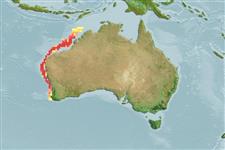Élasmobranches (requins et raies) (sharks and rays) >
Carcharhiniformes (Ground sharks) >
Triakidae (Houndsharks) > Triakinae
Etymology: Mustelus: Latin for weasel, an ancient name for sharks, possibly referring to the pointed snouts, swift movements and/or rapacious feeding behavior of smaller predatory sharks [strictly not tautonymous with Squalus mustelus Linnaeus 1758 since type was designated by the ICZN] (See ETYFish); ravidus: Latin for grayish, referring to its pale-gray dorsal coloration (See ETYFish).
More on authors: White & Last.
Environment: milieu / climate zone / depth range / distribution range
Écologie
marin benthopélagique; profondeur 106 - 300 m (Ref. 72460). Tropical, 116°E - 119°E
Eastern Indian Ocean: Western Australia.
Taille / Poids / Âge
Maturity: Lm ? range ? - ? cm
Max length : 68.3 cm TL mâle / non sexé; (Ref. 72460); 78.8 cm TL (female)
Description synthétique
Clés d'identification | Morphologie | Morphométrie
This species is moderately-sized with the following set of characters: high preanal length to anal-caudal space (9.6-10.5), to dorsal-caudal space (6.1-6.8) ratios; dorsal fins are large, slightly raked back, base length of first dorsal fin (0.8-1) times anal-caudal space; claspers of adult males are relatively long with outer length about 10% TL, terminating only slightly short of anal fin origin; teeth in about 77/73 rows, exposed to a greater extent around symphysis of lower jaw when mouth closed; 90-91 precaudal vertebral centra; 35-37 monospondylous centra; narrow white tip and thin pale margin on first dorsal fin, distinct dusky tip on second
dorsal fin and distinct black tip on terminal caudal lobe (Ref. 72460).
Life cycle and mating behavior
Maturité | Reproduction | Frai | Œufs | Fécondité | Larves
White, W.T. and P.R. Last, 2006. Description of two new species of smooth-hounds, Mustelus widodoi and M. ravidus (Carcharhiniformes: Triakidae) from the western central Pacific. Cybium 30(3):235-246. (Ref. 72460)
Statut dans la liste rouge de l'IUCN (Ref. 130435: Version 2024-1)
Menace pour l'homme
Harmless
Utilisations par l'homme
Outils
Articles particuliers
Télécharger en XML
Sources Internet
Estimates based on models
Preferred temperature (Ref.
123201): 14.4 - 22.1, mean 19.9 °C (based on 22 cells).
Phylogenetic diversity index (Ref.
82804): PD
50 = 0.5000 [Uniqueness, from 0.5 = low to 2.0 = high].
Bayesian length-weight: a=0.00224 (0.00104 - 0.00482), b=3.14 (2.97 - 3.31), in cm total length, based on LWR estimates for this Genus-body shape (Ref.
93245).
Niveau trophique (Ref.
69278): 3.6 ±0.4 se; based on size and trophs of closest relatives
Résilience (Ref.
120179): Faible, temps minimum de doublement de population : 4,5 à 14 années (Preliminary low fecundity).
Fishing Vulnerability (Ref.
59153): Moderate to high vulnerability (52 of 100).
